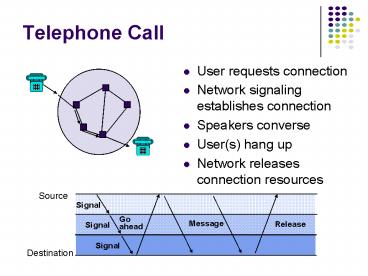Telephone Call - PowerPoint PPT Presentation
1 / 15
Title:
Telephone Call
Description:
Telephone Call. User requests connection. Network signaling ... User(s) hang up. Network releases connection resources. Signal. Source. Signal. Release ... – PowerPoint PPT presentation
Number of Views:162
Avg rating:3.0/5.0
Title: Telephone Call
1
Telephone Call
- User requests connection
- Network signaling establishes connection
- Speakers converse
- User(s) hang up
- Network releases connection resources
2
Call Routing
- Local calls routed through local network (In U.S.
Local Access Transport Area)
(a)
4
C
D
3
2
5
B
A
- Long distance calls routed to long distance
service provider
1
3
Telephone Local Loop
- Local Loop Last Mile
- Copper pair from telephone to CO
- Pedestal to SAI to Main Distribution Frame (MDF)
- 2700 cable pairs in a feeder cable
- MDF connects
- voice signal to telephone switch
- DSL signal to routers
- For interesting pictures of switches MDF, see
- web.mit.edu/is/is/delivery/5ess/photos.html
- www.museumofcommunications.org/coe.html
4
Traffic Management Overload Control
- Telephone calls come and go
- People activity follow patterns
- Mid-morning mid-afternoon at office
- Evening at home
- Summer vacation
- Outlier Days are extra busy
- Mothers Day, Christmas,
- Disasters other events cause surges in traffic
- Need traffic management overload control
5
Traffic concentration
- Traffic fluctuates as calls initiated
terminated - Driven by human activity
- Providing resources so
- Call requests always met is too expensive
- Call requests met most of the time cost-effective
- Switches concentrate traffic onto shared trunks
- Blocking of requests will occur from time to time
- Traffic engineering provisions resources to meet
blocking performance targets
6
Fluctuation in Trunk Occupancy
- Number of busy trunks
- active
- active
- active
- active
- active
- active
- active
- active
- active
- active
7
Modeling Traffic Processes
- Find the statistics of N(t) the number of calls
in the system - Model
- Call request arrival rate l requests per second
- In a very small time interval D,
- Prob new request lD
- Probno new request 1 - lD
- The resulting random process is a Poisson arrival
process
Prob(k arrivals in time T)
- Holding time Time a user maintains a connection
- X a random variable with mean E(X)
- Offered load rate at which work is offered by
users - a l calls/sec E(X) seconds/call (Erlangs)
8
Blocking Probability Utilization
- c Number of Trunks
- Blocking occurs if all trunks are busy, i.e.
N(t)c - If call requests are Poisson, then blocking
probability Pb is given by Erlang B Formula
- The utilization is the average of trunks in use
Utilization ?(1 Pb) EX/c (1 Pb) a/c
9
Blocking Performance
To achieve 1 blocking probability a 5 Erlangs
requires 11 trunks a 10 Erlangs requires 18
trunks
10
Multiplexing Gain
- At a given Pb, the system becomes more efficient
in utilizing trunks with increasing system size - Aggregating traffic flows to share centrally
allocated resources is more efficient - This effect is called Multiplexing Gain
11
Routing Control
- Routing control selection of connection paths
- Large traffic flows should follow direct route
because they are efficient in use of resources - Useful to combine smaller flows to share
resources - Example 3 close COs 3 other close COs
- 10 Erlangs between each pair of COs
17 trunks for 10 Erlangs 9x17153
trunks Efficiency 90/15353
106 trunks for 90 Erlangs Efficiency 85
12
Alternative Routing
- Deploy trunks between switches with significant
traffic volume - Allocate trunks with high blocking, say 10, so
utilization is high - Meet 1 end-to-end blocking requirement by
overflowing to longer paths over tandem switch - Tandem switch handles overflow traffic from other
switches so it can operate efficiently - Typical scenario shown in next slide
13
Typical Routing Scenario
14
Dynamic Routing
- Traffic varies according to time of day, day of
week - East coast of North America busy while West coast
idle - Network can use idle resources by adapting route
selection dynamically - Route some intra-East-coast calls through
West-coast switches - Try high-usage route and overflow to alternative
routes
15
Overload Control
- Overload Situations
- Mothers Day, Xmas
- Catastrophes
- Network Faults
- Strategies
- Direct routes first
- Outbound first
- Code blocking
- Call request pacing































